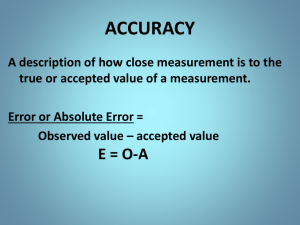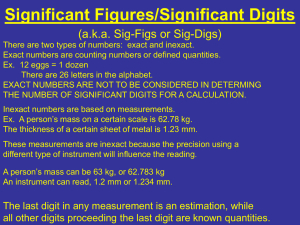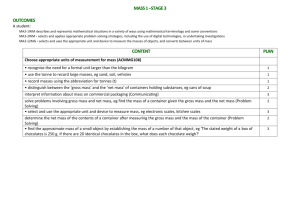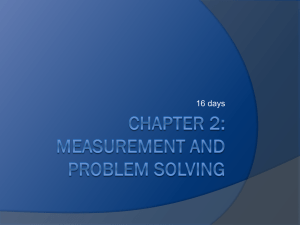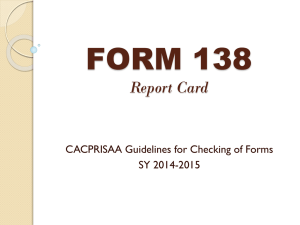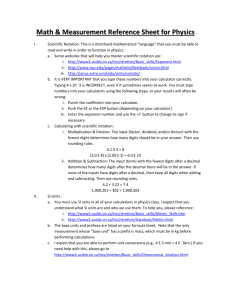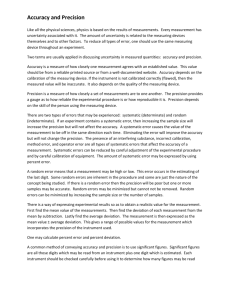Uncertainty in Measurement: Significant Figures Explained
advertisement
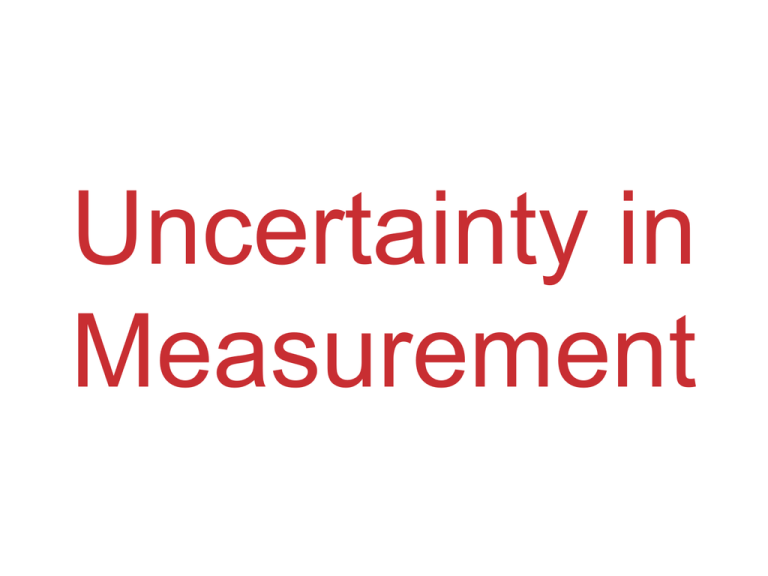
Uncertainty in Measurement Significant Figures • The term significant figures refers to digits that were measured. • When rounding calculated numbers, we pay attention to significant figures so we do not overstate the accuracy of our answers. Significant Figures 1. All nonzero digits are significant. 2. Zeroes between two significant figures are themselves significant. 3. Zeroes at the beginning of a number are never significant. 4. Zeroes at the end of a number are significant if a decimal point is written in the number. Significant Figures • When addition or subtraction is performed, answers are rounded to the least significant decimal place. • When multiplication or division is performed, answers are rounded to the number of digits that corresponds to the least number of significant figures in any of the numbers used in the calculation. Relating Significant Figures to the Uncertainty of a Measurement What difference exists between the measured values 4.0 g and 4.00 g? Solution Many people would say there is no difference, but a scientist would note the difference in the number of significant figures in the two measurements. The value 4.0 has two significant figures, while 4.00 has three. This difference implies that the first measurement has more uncertainty. A mass of 4.0 g indicates that the uncertainty is in the first decimal place of the measurement. Thus, the mass might be anything between 3.9 and 4.1 g, which we can represent as 4.0 ± 0.1 g. A measurement of 4.00 g implies that the uncertainty is in the second decimal place. Thus, the mass might be anything between 3.99 and 4.01 g, which we can represent as 4.00 ± 0.01 g. Without further information, we cannot be sure whether the difference in uncertainties of the two measurements reflects the precision or accuracy of the measurement. PRACTICE EXERCISE A balance has a precision of ± 0.001 g. A sample that has a mass of about 25 g is placed on this balance. How many significant figures should be reported for this measurement? Answer: five, as in the measurement 24.995 g SAMPLE EXERCISE 1.6 Determining the Number of Significant Figures in a Measurement How many significant figures are in each of the following numbers (assume that each number is a measured quantity): (a) 4.003, Four; the zeros are significant figures (b) 6.023 1023, Four; the exponential term does not add to the number of significant figures. (c) 5000? One. We assume that the zeros are not significant when there is no decimal point shown. If the number has more significant figures, a decimal point should be employed or the number written in exponential notation. Thus, 5000. has four significant figures, whereas 5.00 103 has three. PRACTICE EXERCISE How many significant figures are in each of the following measurements: Answers: (a) 3.549 g, (a) four, (b) two, (b) 23 104 cm, (c) three (c) 0.00134 m3? Determining the Number of Significant Figures in a Calculated Quantity The width, length, and height of a small box are 15.5 cm, 27.3 cm, and 5.4 cm, respectively. Calculate the volume of the box, using the correct number of significant figures in your answer. Solution The volume of a box is determined by the product of its width, length, and height. In reporting the product, we can show only as many significant figures as given in the dimension with the fewest significant figures, that for the height (two significant figures): When we use a calculator to do this calculation, the display shows 2285.01, which we must round off to two significant figures. Because the resulting number is 2300, it is best reported in exponential notation, 2.3 103, to clearly indicate two significant figures. PRACTICE EXERCISE It takes 10.5 s for a sprinter to run 100.00 m. Calculate the average speed of the sprinter in meters per second, and express the result to the correct number of significant figures. Answer: 9.52 m/s (3 significant figures) Determining the Number of Significant Figures in a Calculated Quantity A gas at 25°C fills a container whose volume is 1.05 103 cm3. The container plus gas have a mass of 837.6 g. The container, when emptied of all gas, has a mass of 836.2 g. What is the density of the gas at 25°C? Solution To calculate the density, we must know both the mass and the volume of the gas. The mass of the gas is just the difference in the masses of the full and empty container: (837.6 – 836.2) g = 1.4 g In subtracting numbers, we determine the number of significant figures in our result by counting decimal places in each quantity. In this case each quantity has one decimal place. Thus, the mass of the gas, 1.4 g, has one decimal place. Using the volume given in the question, 1.05 103 cm3, and the definition of density, we have In dividing numbers, we determine the number of significant figures in our result by counting the number of significant figures in each quantity. There are two significant figures in our answer, corresponding to the smaller number of significant figures in the two numbers that form the ratio. To how many significant figures should the mass of the container be measured (with and without the gas) in Sample Exercise 1.8 in order for the density to be calculated to three significant figures? Answer: five (In order for the difference in the two masses to have three significant figures, there must be two decimal places in the masses of the filled and empty containers.) Accuracy versus Precision • Accuracy refers to the proximity of a measurement to the true value of a quantity. • Precision refers to the proximity of several measurements to each other.
